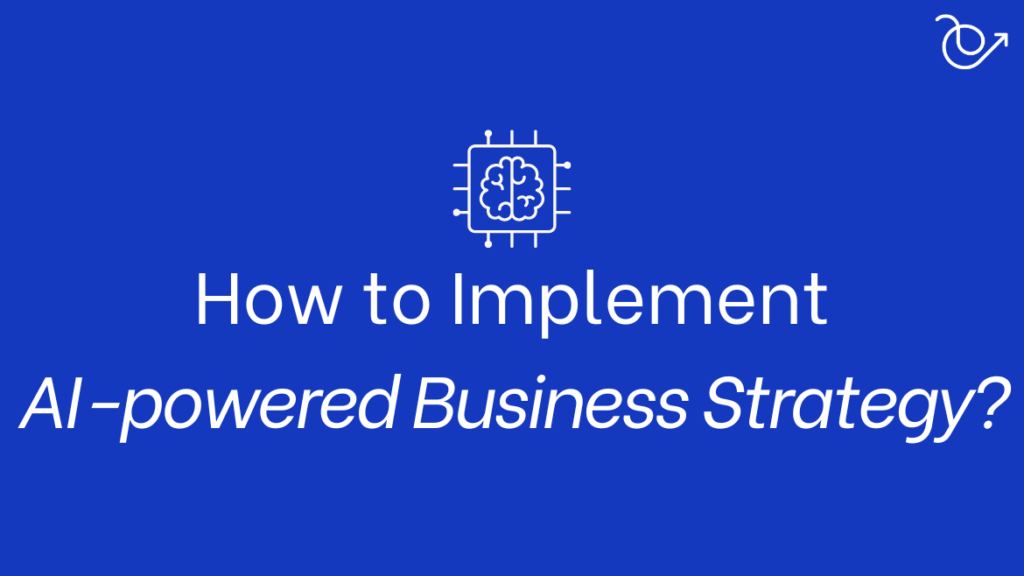A few years ago, AI felt like a futuristic luxury—something only tech giants could afford to experiment with.
But today, AI is at the core of business strategy across industries, from startups leveraging AI-driven sales automation to Fortune 500 companies optimizing supply chains with predictive analytics.
According to a 2023 McKinsey report, 50% of companies have already adopted AI in at least one function, with the highest impact seen in sales, marketing, and operations.
And yet, many businesses are still uncertain about how to implement AI effectively.
As a RevOps consultant, I work with businesses that want to integrate AI but struggle with questions like:
✅ Where should we start?
✅ What tools should we use?
✅ How do we measure success?
This guide will help you build an AI-powered business strategy that’s practical, scalable, and delivers real ROI.
Let’s dive in.
Understanding AI’s Role in Business Strategy
Before implementing AI, let’s get clear on what AI actually does in a business setting.
At its core, AI helps you:
- Automate repetitive tasks (chatbots, data entry, email outreach)
- Analyze large datasets for actionable insights (predictive analytics, trend forecasting)
- Improve decision-making with real-time data (AI-driven sales forecasting, personalized marketing)
Key AI Technologies Businesses Should Leverage
- Machine Learning (ML): Identifies patterns and predicts outcomes (e.g., AI-driven lead scoring in sales).
- Natural Language Processing (NLP): Helps chatbots, sentiment analysis, and AI-powered assistants (e.g., ChatGPT).
- Computer Vision: Used in quality control, facial recognition, and supply chain monitoring.
- Predictive Analytics: Forecasts trends based on historical data (e.g., sales forecasting tools like Clari or Gong).
Real-World Example: AI in Sales Strategy
How Salesforce Uses AI: Their Einstein AI analyzes customer interactions, assigns lead scores, and even suggests the best time to reach out to prospects—helping sales teams increase conversions by up to 30%.
What are the Best AI Use Cases for Your Business?
AI isn’t one-size-fits-all—it should be integrated into areas where it drives the most value.
Key AI Applications for Business
1. Sales & Revenue Operations
✅ AI-driven lead scoring (e.g., HubSpot AI-powered CRM)
✅ Sales forecasting to predict quarterly performance
✅ AI chatbots for automated lead qualification
✅ Personalized outreach via AI-driven email assistants
For Example: A SaaS company using AI to prioritize high-value leads saw a 20% increase in conversion rates by focusing efforts on the most promising prospects.
2. Marketing & Customer Experience
✅ AI-powered content personalization (e.g., Netflix-style recommendations)
✅ Chatbots for 24/7 customer support
✅ AI-driven ad targeting for better ROI
For Example: eCommerce brands using AI-powered email segmentation have reported uplifts of 40% in email open rates and 20%+ in revenue per email.
#TCCRecommends: How to Implement AI in Customer Service?
3. Operations & Supply Chain Management
✅ Demand forecasting with AI-driven predictive analytics
✅ Automated inventory management to reduce waste
✅ AI-powered logistics optimization
For Example: Amazon’s AI-based warehouse management system reduces operational costs by 10-40%, enabling faster, more efficient deliveries.
4. Finance & Risk Management
✅ AI fraud detection systems (used by banks and fintech firms)
✅ AI-driven risk assessment for loans and credit approvals
✅ AI-powered forecasting for budgeting and investments
For Example: JPMorgan’s COiN AI processes hundreds of thousands of legal documents in seconds, saving 360,000 hours of manual work annually.
Steps to Building an AI-Powered Business Strategy
Step 1: Define Clear Business Goals
AI isn’t magic—it needs direction. Ask:
- What problem are we solving? (e.g., low conversion rates, inefficient lead scoring)
- What metric will measure success? (e.g., 20% increase in sales pipeline efficiency)
Step 2: Gather & Organize Quality Data
AI is only as good as the data you feed it. Ensure:
- Clean, structured data (avoid missing, duplicate, or irrelevant data)
- Data is collected across departments for a holistic approach
Step 3: Choose the Right AI Tools
There are no-code AI tools that integrate seamlessly:
- HubSpot AI (Sales & Marketing)
- Gong (AI-driven revenue intelligence)
- Tableau with AI (Data visualization & analytics)
Step 4: Pilot AI in a Small, Controlled Project
Test AI in one business function before scaling.
For example: Use AI-powered chatbots for lead qualification before expanding to full customer support.
Step 5: Continuously Optimize & Scale
AI isn’t a set-it-and-forget-it tool. Regularly:
- Analyze AI-driven insights
- Adjust strategies based on real-time performance
- Train your team to work alongside AI
How to Overcome Challenges of Adopting AI-powered Business Strategy?
AI implementation isn’t without hurdles. Here’s how to overcome common challenges:
1. High Costs & ROI Concerns
Solution: Start with low-cost, high-impact AI tools (e.g., AI-driven CRMs, chatbots).
2. Data Privacy & Compliance Risks
Solution: Follow GDPR, CCPA guidelines and invest in AI governance frameworks.
3. Resistance from Employees
Solution: Educate teams on AI’s role in enhancing their work rather than replacing them.
The Future of AI-Powered Business Strategy
AI is evolving rapidly. Here’s what’s next:
- Generative AI – AI creating sales scripts, marketing content, and even video ads.
- AI-Powered Sales Assistants – AI-driven reps closing deals autonomously.
- Hyper-Personalization – AI predicting customer behavior with 90%+ accuracy.
Companies that embrace AI now will outperform competitors in efficiency, customer experience, and revenue growth.
Conclusion: Start Small, Scale Fast
AI isn’t a luxury anymore—it’s a necessity. But the key to success is starting small and scaling strategically.
✅ Identify high-impact AI use cases
✅ Use practical AI tools that integrate easily
✅ Continuously analyze, optimize, and train your teams
As a RevOps consultant, I help businesses navigate AI implementation without the confusion. If you’re ready to explore AI-powered growth, let’s chat!
